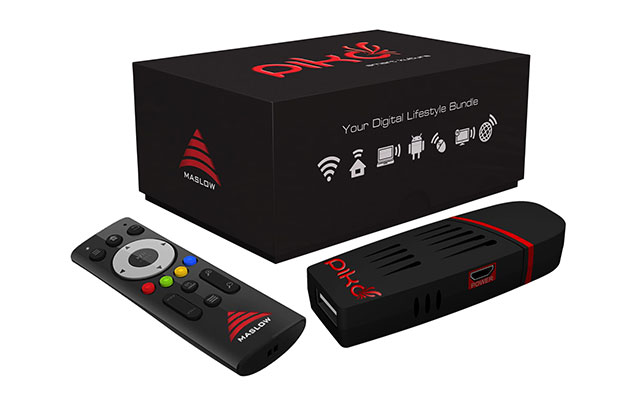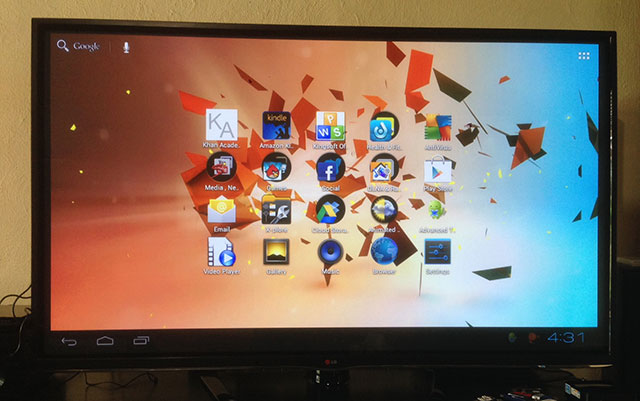
A Durban-based company, Maslow Holdings, has developed a gizmo that promises to turn any HDMI-enabled television set into a smart TV. The R1 195 Piko “smart stick” is the size of a USB flash drive and connects to a TV through HDMI.
The Piko smart stick, which is manufactured in Durban, runs Android 4.0 “Ice Cream Sandwich”, has 1GB of RAM, 8GB of storage (about 2GB available to users) and built-in Wi-Fi.
Inside the box is an HDMI extender, USB power supply, four-port USB hub, USB converter, Air Mouse and receiver, USB SD/MMC/RS-MMC reader, micro SD adapter and 2x AAA batteries. All you need to use the device is a HDMI-capable TV with spare USB port.
The Piko smart stick is a hybrid of a mini PC and tablet on a large screen, with “air mouse” (wireless point and click) controls.
Once the Piko is plugged into a spare HDMI port and the air mouse, which comes with a USB receiver, has been connected and paired, it is ready to use.
Anyone familiar with Android will quickly figure their way around the Piko’s software and they may only need to adjust to the idea of using an air mouse. The sensitivity of the mouse can be adjusted under settings, but the default setting works well.
The home screen layout looks just like an Android tablet, with Google search at the top left, app drawer at the top right, and back, home and multitasking buttons on the bottom left.
The home screen consists entirely of pre-installed apps. They include Khan Academy, Amazon Kindle, Kingsoft Office, AntiVirus, social networks such as Facebook and Twitter, and a selection of games such Angry Birds and Fruit Ninja. There’s also YouTube, SuperSport, News24, an e-mail app and Google Drive. Other options include video player, gallery, music, browser and X-Plore, a file manager.
To get content onto the Piko, you can plug it into a PC or laptop through USB and browse the device like any other Android-based product. Users can drag and drop content onto the Piko or, alternatively, make use of the USB card reader with micro SD card adaptor and access content from another source.
The Piko’s software runs fairly smoothly: there was no sluggishness between browsing and running multiple apps, but we did kill apps running in the background once we were done with them.
Playing Fruit Ninja and Angry Birds with the air mouse felt like it was the first time we were playing them, mostly due to not using an air mouse before. In Fruit Ninja, it felt as if there was a one-second delay between actions, but it didn’t take away the full experience of the game.
Using the built-in Web browser or other apps that require typing is terribly time consuming when using the air mouse, especially switching between screens of characters. However, the four-port USB hub comes in handy as you are able to plug in a keyboard to speed things up.

The Piko could find a home for those who can’t justify the cost of a full PC. It’s also a cheap solution for those who want a tablet experience — to an extent — without purchasing a tablet. But plugging in a keyboard is highly recommended.
The Piko also appears aimed at those who are looking to watch multimedia content on an HD TV by copying files to the device or stream content to it from any device on the same network.
We tested the live streaming feature, but had a few issues. The manual does not tell users to install the MediaHouse app for Android or a DLNA player for iOS.
We managed to get onto an iPhone 5 from the Piko, went into our multimedia folder, but could not play any music from the tracks visible on screen, which were all free of digital rights management software.
We also had no luck connecting the Android handset to the Piko through the streaming service. This problem could be fixed through an app update or it’s just a matter of finding another third-party DLNA player. However, we did manage to browse an Android phone — an LG G2 — after turning it into wireless storage device, and using the X-Plore file manager, but files loaded very slowly across the network.
Nevertheless, we think the Piko would be an excellent device for schools wanting to provide access easily and cheaply to students who need to use educational apps or just access to the Internet for research. It could also be used as a learning aid in classrooms.
While there are several really cheap Android tablets available in South Africa, none of them run Android 4.0 or have specs similar to the Piko, which also has full HD capabilities.
The Piko smart stick is available at selected Game stores for a recommended retail price of R1 195. — (c) 2014 NewsCentral Media

